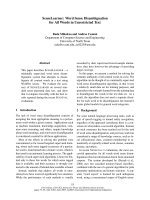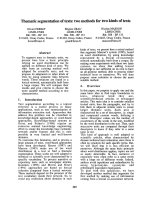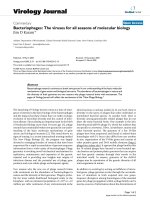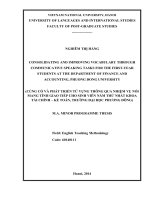WORD FORM STRESS FOR ALL KINDS OF STUDENTS
Bạn đang xem bản rút gọn của tài liệu. Xem và tải ngay bản đầy đủ của tài liệu tại đây (1.18 MB, 20 trang )
Ôn thi THPTQG
Chuyên đề từ vựng
Thành ngữ
Phát âm
Trọng âm
Từ mới
Từ loại
(Word
form)
Cụm từ
Đồng nghĩa
Trái nghĩa
Prefix - Suffix
Tiền tố - Hậu tố
Unhappy
(adj)
–
Happy
(adj)
-
Happiness
(n)
- Tiền tố: Yếu tố đưa vào trước từ gốc và làm thay đổi nghĩa của từ
- Hậu tố: Yếu tố đưa vào sau từ gốc và làm thay đổi từ loại của từ
Hậu tố
Phân biệt từ loại dựa trên
hậu tố
Danh từ - Tính từ - Trạng từ
1. Các hậu tố thành lập danh từ
- Hậu tố chỉ người / nghề nghiệp: er, or, ist, ess, ant, man, ee
+ Động từ + er/ or => danh từ
Eg: worker, teacher, runner, player, visitor, …
+ -ist: Artist (nghệ sỹ)
+ -ess: Waitress, hostess
+ -ant: Accountant, assistant
+ -man: Postman, fireman
+ -ee: Trainee, employee
1. Các hậu tố thành lập danh từ
- Hậu tố tion/ sion
Eg: nation, education, impression, television, ….
- Hậu tố ment/ ce
Eg: movement, environment, difference, independence
- Hậu tố ness/ y/ ship (chỉ trạng thái, phẩm chất, nhóm) / ure
Eg: kindness, beauty, friendship, membership, nature, culture, …
2. Các hậu tố thành lập tính từ
- Hậu tố al/ ive (thuộc về)
Eg: National (thuộc về quốc gia)
Cultural (thuộc về văn hóa)
Active, Attractive
- Hậu tố ent/ ant
Eg: independent, important,…
2. Các hậu tố thành lập tính từ
- Hậu tố less, full
Less
Phủ định, tiêu cực
Full
có, đầy, tích cực
Careless
Carefull
(cẩu thả)
(cẩn thận)
2. Các hậu tố thành lập tính từ
- Hậu tố able/ ous (có thể, đầy…)
Eg: comfortable, dangergous, famous
- Hậu tố cult
Eg: difficult
- Hậu tố ish (có vẻ)/ ic (thuộc về)
Eg: childish, selfish, economic, classic
- Hậu tố đuôi ed (có cảm giác)
Eg: bored, interested, excited
- Hậu tố đuôi ing (làm)
Eg: boring, interesting, exciting
2. Các hậu tố thành lập tính từ
- Danh từ + y (chỉ mùi vị, thời tiết)
Eg: sunny, windy
- Danh từ + ly (hằng / có vẻ)
Eg: monthly, daily, lovely, friendly, …
- Hậu tố ty (mươi)
Eg: twenty, sixty, ….
- Hậu tố ible (có thể)
Eg: exhaustible (có thể bị hao mòn)
- Hậu tố ward (về phía)
Eg: seaward (về phía biển), backward (về phía sau)
Cách ghi nhớ hậu tố của tính từ
Tính từ đằng cuối như vầy
OUS, Y nhiều có, FULL đầy, LESS không
ALIVE sống sót, thuộc về
ISH hơi, có vẻ, WARD về, TY mươi
LIKE như, ED có, ING làm
ABLE có thể, đôi lần IBLE
Thuộc về IC đấy , nhé ENT
ANT tâm đã có, LY hằng tháng day.
3. Các hậu tố thành lập trạng từ
- Hậu tố ly: tính từ + ly (một cách)
Eg: slowly, quickly
- Hậu tố wards: danh từ + wards (về phía)
Eg: Seawards (về phía biển), skywards (về phía bầu trời)
Những chú ý khi thành lập trạng từ từ tính từ
1. Khi tính từ tận cùng là “le” ta bỏ “e” rồi cộng thêm “y”
Gentle ->
gently
2. Tính từ tận cùng bằng đuôi “ic” ta thêm “al” rồi cộng thêm “ly”
Economic ->
economically
3. Tính từ tận cùng Easy ->
bằng “y” ta đổi “y”easily
-> i + ly
Good ->
well
4. Tính từ biến đổi hoàn
toàn khi chuyển
sang trạng từ
5. Một số ADJ có Friendly ->
tận cùng bằng “ly” -> in
taathành
lậpway
ADV theo cấu
friendly
trúc: in a/an + adj-ly + way
* Một số tính từ biến đổi sang trạng từ
giữ NGUYÊN
1. Hard
2. Fast
3. Late
4. Early
5. Monthly
6. Daily
7. Near
8. Far
9. Right
10. Wrong
11. Low
12. High
13. Straight
Phân biệt từ loại
1. Beauty (n)
2. Educate (v)
3. Importance
(n)
Beautiful (adj)
Beautifully (adv)
Education (n)
Educational (adj)
Important (adj)
Importantly (adv)
Hướng dẫn làm bài tập từ loại
Ex: Choose the best answer
Question 1: Several measures have been proposed to ______ the problem of
unemployment among university graduates.
A. pose
B. admit
C. address
D. create
Question 2: The presenter started his speech with a few ______ jokes to build
rapport with the audience.
A. whole-hearted B . light-hearted C. soft-hearted
D. kind-hearted
N
Question 3: Candidates are advised to dress formally to make a good _____ on job
interviewers.
A. impress
B. impressively C. impression
D. impressive
Question 4: If Martin were here now, he ______ us to solve this difficult problem.
A. would help
B. helps
C. will help
D. has helped
Question 5: You shouldn't lose heart; success often comes to those who are not ____
by failures. .
Chọn
Nhận A.
biếtleft
câu
hỏi
out
B.
putđịnh
off từ loại cần
C. điền
switched offNhận
C.diện
turned
Xác
đápon
án
“key”
Tham khảo đề thi THPTQG
Từ loại
Code: 401
Question 20: Candidates are advised to dress formally to make a good ______ on
job interviewers. .
A. impress
B. impressively
C. impression
D. impressive
Code: 402
Question 14: It is believed that travelling is a good way to expand our ______ of the
world.
A. knowledgeable
B . knowledgeably C. knowledge
D. know
Code: 403
Question 20: Susan has achieved great ______ in her career thanks to her hard
work.
A. success
B. succeed
C. successful
D. successfully
Code: 404
Question 5: Participating in teamwork activities helps students develop their
______ skills.
A. social
B. society
C. socially
D . socialise
2. Cách đánh dấu trọng âm từ 3 âm trở lên
- Trọng âm rơi vào âm tiết thứ hai tính từ cuối lên với các từ có hậu tố là:
‘-ic’ ‘-ion’ ‘-ious’ ‘-ity’ ‘-ive’ ‘-eous’ ‘-graphy’ ‘-ial’
Eg: eco’nomic /ˌiːkəˈnɑːmɪk/, so’lution /səˈluː.ʃən/,
pro’fession /prəˈfeʃ.ən/
- Trọng âm rơi vào âm tiết thứ ba tính từ cuối lên với các từ có hậu tố là: -ate, -cy, ty, -phy, -gy, -my, -try -ible, -ary, -ant, -ical, -ual, -ance/ ence, -ify, -al/ ar, -uous
Eg: ‘privacy /ˈpraɪvəsi /,
credi’bility /ˌkredəˈbɪləti/, phot’ography /fəˈtɑːɡrəfi /,
ge’ology /dʒiˈɑːlədʒi/, ’practical /ˈpræktɪkl/,
con'siderate /kənˈsɪd.ər.ət/
- Trọng âm rơi vào chính các hậu tố sau: “-ee”, “-eer”, “-ese”, “-aire”, “-ique”,
“-esque” và“ -ain” (chỉ áp dụng cho động từ)
Eg: enter’tain / entə‘tein/,
refu’gee /,refju:’dʒi:/,
volun’teer /,vɔlən’tiə/
Tham khảo đề thi THPTQG
Trọng âm
Mark the letter A, B, C, or D on your answer sheet to indicate the word that
differs from the other three in the position of primary stress in each of the
following questions.
401: Question 9: A. sympathy B. poverty
C. equipment D. character
r
/ˈkær.ək.tə /
/ˈpɒv.ə.ti/
/ɪˈkwɪp.mənt/
402: Question 3: A. /əꞌpɑ:tmənt/
apartment B./'benɪfɪt/
benefit
C./ꞌɑ:gjumənt/
argument
D./ꞌveɪkənsi/
vacancy
403: Question 4: A. /dɪˈzɑː.stə
disasterr/
B./ˈɒr.ɪ.dʒɪn/
origin
C./ˈtʃær.ə.ti/
charity
ə
D.
agency
/ˈeɪ.dʒ
n.si/
ə
nt/
404: Question 21: A./ˈprez.ɪ.d
president
B./əˈpəʊ.nənt/
opponent
ə
nt/
C./əˈsɪs.t
assistant
/kəmˈpæn.jən/
C.
companion
/ˈsɪm.pə.θi/
3. Cách đánh dấu trọng âm từ 2 âm
- Trọng âm rơi vào âm tiết thứ hai tính từ cuối lên với các từ có hậu tố là:
‘-ic’ ‘-ion’ ‘-ious’ ‘-ity’ ‘-ive’ ‘-eous’ ‘-graphy’ ‘-ial’
Eg: eco’nomic /ˌiːkəˈnɑːmɪk/, so’lution /səˈluː.ʃən/,
pro’fession /prəˈfeʃ.ən/
- Trọng âm rơi vào âm tiết thứ ba tính từ cuối lên với các từ có hậu tố là: -ate, -cy, ty, -phy, -gy, -my, -try -ible, -ary, -ant, -ical, -ual, -ance/ ence, -ify, -al/ ar, -uous
Eg: ‘privacy /ˈpraɪvəsi /,
credi’bility /ˌkredəˈbɪləti/, phot’ography /fəˈtɑːɡrəfi /,
ge’ology /dʒiˈɑːlədʒi/, ’practical /ˈpræktɪkl/,
con'siderate /kənˈsɪd.ər.ət/
- Trọng âm rơi vào chính các hậu tố sau: “-ee”, “-eer”, “-ese”, “-aire”, “-ique”,
“-esque” và“ -ain” (chỉ áp dụng cho động từ)
Eg: enter’tain / entə‘tein/,
refu’gee /,refju:’dʒi:/,
volun’teer /,vɔlən’tiə/
Thank you for
your listening









